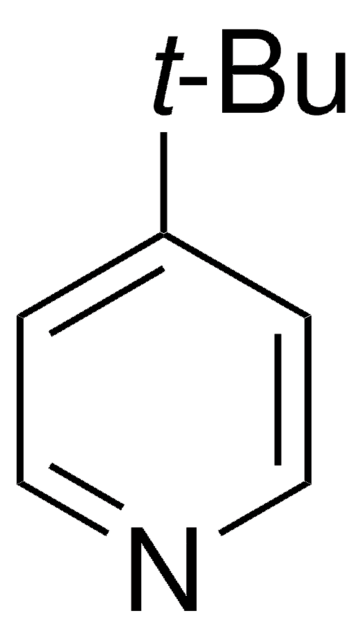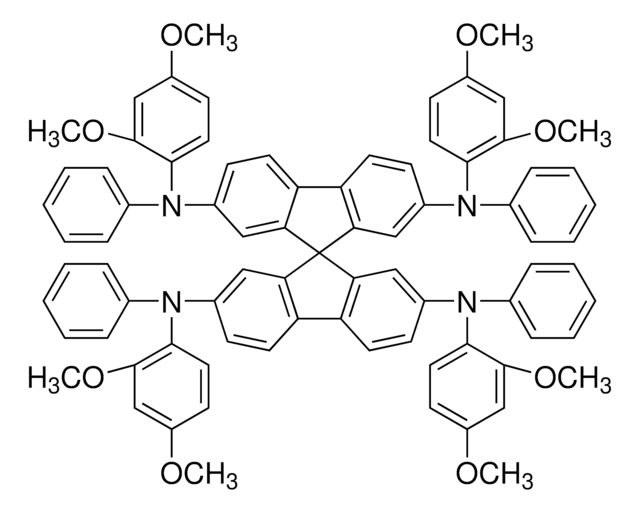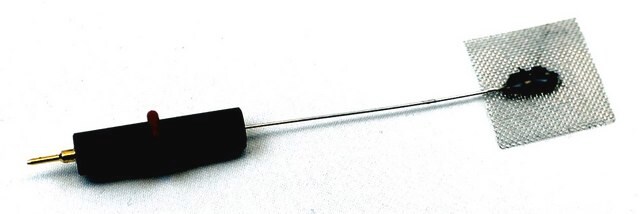791539
Titania paste, reflector
Sinonimo/i:
Greatcell Solar® WER2-O, TiO2 paste
About This Item
Prodotti consigliati
Descrizione
Crystal Structure: > 99% anatase (analysis carried out on starting material, prior to paste manufacture)
Forma fisica
paste (white)
Concentrazione
20.0 wt. % (+/- 1.2 wt%)
Dimens. media delle particelle
150-250 nm (scatter)
Viscosità
15000-25000 mPa.s (Analysis carried out with 20mm 4 degree cone/plate; 40 s-1)
InChI
1S/2O.Ti
GWEVSGVZZGPLCZ-UHFFFAOYSA-N
Descrizione generale
Applicazioni
Scattering Titania Paste contains highly dispersed anatase scattering particles (150nm to 250nm). This paste produces a non-active scattering layer when applied onto a pre-printed active layer.
After drying; this paste must be fired – together with the pre-printed active layers – at or above 500°C. This results in an opaque sintered layer; with a thickness of ~3μm for one printed layer; when using a 90T mesh screen.
Storage: Store in the dark at 20°C
Note legali
Greatcell Solar® is a registered trademark of Greatcell Solar
Avvertenze
Warning
Indicazioni di pericolo
Consigli di prudenza
Classi di pericolo
Eye Irrit. 2 - Skin Irrit. 2
Codice della classe di stoccaggio
10 - Combustible liquids
Classe di pericolosità dell'acqua (WGK)
WGK 1
Punto d’infiammabilità (°F)
195.8 °F
Punto d’infiammabilità (°C)
91 °C
Certificati d'analisi (COA)
Cerca il Certificati d'analisi (COA) digitando il numero di lotto/batch corrispondente. I numeri di lotto o di batch sono stampati sull'etichetta dei prodotti dopo la parola ‘Lotto’ o ‘Batch’.
Possiedi già questo prodotto?
I documenti relativi ai prodotti acquistati recentemente sono disponibili nell’Archivio dei documenti.
I clienti hanno visto anche
Articoli
Few Monolayer Atomic Layer Deposition (ALD) on Surfaces and Interfaces for Energy Applications
Dye-sensitized solar cells (DSCs) are 3rd generation solar cells combining the promise of high efficiency with low production costs.
Organic photovoltaics (OPVs) represent a low-cost, lightweight, and scalable alternative to conventional solar cells. While significant progress has been made in the development of conventional bulk heterojunction cells, new approaches are required to achieve the performance and stability necessary to enable commercially successful OPVs.
While dye sensitization as the basis for color photography has been accepted for a very long time,1 attempts to use this principle for the conversion of solar light to electricity generally had resulted only in very low photocurrents, below 100 nA/cm2.2
Il team dei nostri ricercatori vanta grande esperienza in tutte le aree della ricerca quali Life Science, scienza dei materiali, sintesi chimica, cromatografia, discipline analitiche, ecc..
Contatta l'Assistenza Tecnica.






![Dipyrazino[2,3-f:2′,3′-h]quinoxaline-2,3,6,7,10,11-hexacarbonitrile 95% (HPLC)](/deepweb/assets/sigmaaldrich/product/structures/151/558/c0e2c95f-5228-4864-a7a5-4b9765a19840/640/c0e2c95f-5228-4864-a7a5-4b9765a19840.png)


